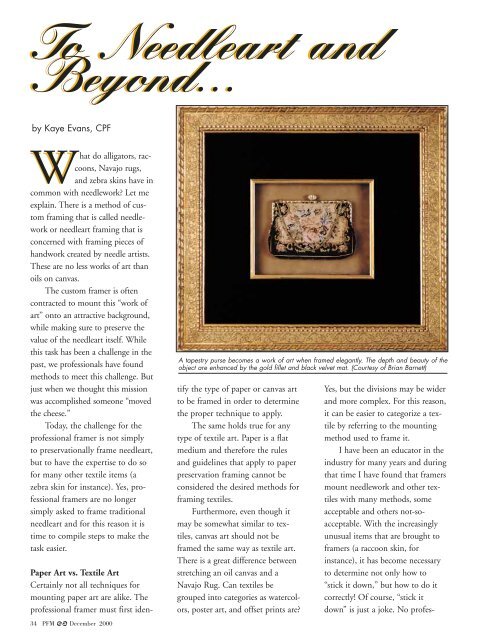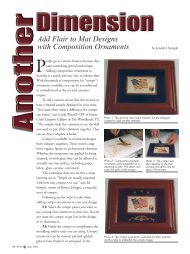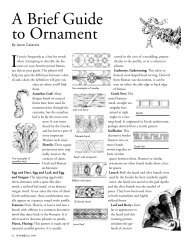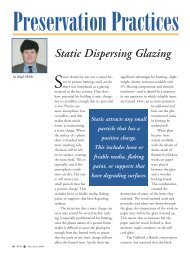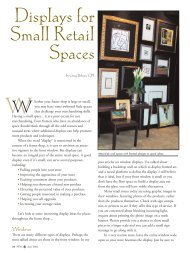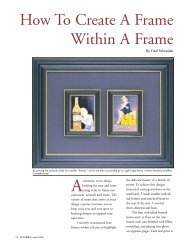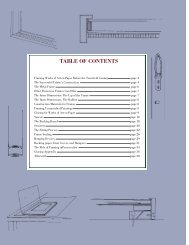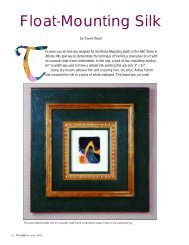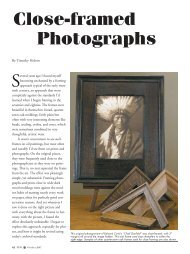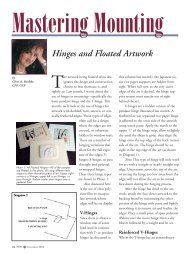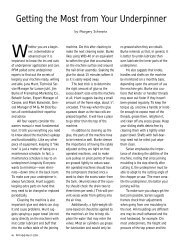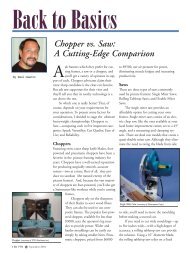To Needleart and Beyond - Picture Framing Magazine
To Needleart and Beyond - Picture Framing Magazine
To Needleart and Beyond - Picture Framing Magazine
Create successful ePaper yourself
Turn your PDF publications into a flip-book with our unique Google optimized e-Paper software.
<strong>To</strong> <strong>Needleart</strong> <strong>and</strong><br />
<strong>Beyond</strong>...<br />
by Kaye Evans, CPF<br />
W<br />
What do alligators, raccoons,<br />
Navajo rugs,<br />
<strong>and</strong> zebra skins have in<br />
common with needlework? Let me<br />
explain. There is a method of custom<br />
framing that is called needlework<br />
or needleart framing that is<br />
concerned with framing pieces of<br />
h<strong>and</strong>work created by needle artists.<br />
These are no less works of art than<br />
oils on canvas.<br />
The custom framer is often<br />
contracted to mount this “work of<br />
art” onto an attractive background,<br />
while making sure to preserve the<br />
value of the needleart itself. While<br />
this task has been a challenge in the<br />
past, we professionals have found<br />
methods to meet this challenge. But<br />
just when we thought this mission<br />
was accomplished someone “moved<br />
the cheese.”<br />
<strong>To</strong>day, the challenge for the<br />
professional framer is not simply<br />
to preservationally frame needleart,<br />
but to have the expertise to do so<br />
for many other textile items (a<br />
zebra skin for instance). Yes, professional<br />
framers are no longer<br />
simply asked to frame traditional<br />
needleart <strong>and</strong> for this reason it is<br />
time to compile steps to make the<br />
task easier.<br />
Paper Art vs. Textile Art<br />
Certainly not all techniques for<br />
mounting paper art are alike. The<br />
professional framer must first iden-<br />
34 PFM i December 2000<br />
A tapestry purse becomes a work of art when framed elegantly. The depth <strong>and</strong> beauty of the<br />
object are enhanced by the gold fillet <strong>and</strong> black velvet mat. (Courtesy of Brian Barnett)<br />
tify the type of paper or canvas art<br />
to be framed in order to determine<br />
the proper technique to apply.<br />
The same holds true for any<br />
type of textile art. Paper is a flat<br />
medium <strong>and</strong> therefore the rules<br />
<strong>and</strong> guidelines that apply to paper<br />
preservation framing cannot be<br />
considered the desired methods for<br />
framing textiles.<br />
Furthermore, even though it<br />
may be somewhat similar to textiles,<br />
canvas art should not be<br />
framed the same way as textile art.<br />
There is a great difference between<br />
stretching an oil canvas <strong>and</strong> a<br />
Navajo Rug. Can textiles be<br />
grouped into categories as watercolors,<br />
poster art, <strong>and</strong> offset prints are?<br />
Yes, but the divisions may be wider<br />
<strong>and</strong> more complex. For this reason,<br />
it can be easier to categorize a textile<br />
by referring to the mounting<br />
method used to frame it.<br />
I have been an educator in the<br />
industry for many years <strong>and</strong> during<br />
that time I have found that framers<br />
mount needlework <strong>and</strong> other textiles<br />
with many methods, some<br />
acceptable <strong>and</strong> others not-soacceptable.<br />
With the increasingly<br />
unusual items that are brought to<br />
framers (a raccoon skin, for<br />
instance), it has become necessary<br />
to determine not only how to<br />
“stick it down,” but how to do it<br />
correctly! Of course, “stick it<br />
down” is just a joke. No profes-
sional framer out there is actually<br />
sticking stuff down, right?<br />
Methods of Textile <strong>Framing</strong><br />
It is essential to establish specific<br />
<strong>and</strong> detailed techniques for framing<br />
works of art consisting of<br />
fibers.<br />
Lacing Technique: This method<br />
is used when, in order for the finished<br />
design to be aesthetically<br />
pleasing, the textile<br />
edges must be covered or<br />
rolled to the reverse side.<br />
An example of this is a<br />
piece of counted crossstitch,<br />
a type of needleart<br />
that falls under the larger<br />
umbrella of textile framing.<br />
In a counted cross-stitch,<br />
colorful cotton <strong>and</strong>/or<br />
metallic threads are stitched<br />
into a evenweave fiber by<br />
threading small x’s in <strong>and</strong><br />
out of the intersections of<br />
the fabric until the threads<br />
are united <strong>and</strong> the small x’s<br />
have created a finely<br />
detailed picture.<br />
<strong>To</strong> the eye of the<br />
beholder cross-stitch is as<br />
valuable as any original<br />
work of art <strong>and</strong> the professional<br />
framer should accept<br />
this <strong>and</strong> reject the “just stick it<br />
down” techniques. More modern<br />
day textiles include batik, a fiber<br />
design created using a wax resist<br />
<strong>and</strong> dyes to create a global textile<br />
that traditionally comes from exotic<br />
places like Africa.<br />
Typically the edges of these<br />
types of textile are not attractive<br />
<strong>and</strong> most people prefer that the<br />
edges be hidden. So, we lace them.<br />
The technique of lacing has been<br />
used for centuries to safely attach a<br />
fibered work of art to a mount<br />
36 PFM i December 2000<br />
board. It is accomplished by pulling<br />
the excess fabric to the reverse side,<br />
tying off the corners, <strong>and</strong> then the<br />
sides using lacing technique.<br />
(Details on this technique can be<br />
found in “Lacing <strong>Needleart</strong>,” PFM,<br />
December 1999.)<br />
Couching Technique: This technique<br />
is used when the art would<br />
be best served with the edges show-<br />
The rich fabric used in this shadowbox highlights the detail of the<br />
couched gloves <strong>and</strong> beaded bag. The gold fillet adds richness to the<br />
final creation.<br />
ing. This technique is more commonly<br />
used in mounting most<br />
types of textile art other than<br />
needleart. Examples are a crocheted<br />
doily, an alligator skin, a Navajo<br />
rug, or a zebra skin. Typically the<br />
edges of these types of art are interesting<br />
<strong>and</strong> hiding them would take<br />
away from the beauty of the piece.<br />
The art must be first carefully<br />
pinned to a substrate (consisting of<br />
a finished fiber) or board that will<br />
lend support as well as be an<br />
attractive background for the tex-<br />
tile. One by one, the pins are<br />
replaced by small stitches of thread<br />
that is as close to the fiber of the<br />
art as possible.<br />
The majority of the thread travels<br />
underneath the substrate with<br />
only a small stitch coming to the<br />
surface to capture the textile <strong>and</strong><br />
safely hold it onto the substrate or<br />
mounting board. The distance<br />
between these tiny stitches will<br />
be determined by the weight of<br />
the textile being held. Close the<br />
distance with heavier textiles<br />
<strong>and</strong> widen the distance with<br />
light, delicate textiles. (Details<br />
on this technique can be found<br />
in “The Couching Technique<br />
for <strong>Needleart</strong> <strong>Framing</strong>,” PFM,<br />
December 1995.)<br />
Choosing the Correct <strong>To</strong>ols<br />
Threads: The threads used for<br />
textile framing are as important<br />
as the stitching itself. Try<br />
to use a thread as close to the<br />
fiber of the textile as possible.<br />
Take the example of a football<br />
jersey, typically made of polyester.<br />
The longevity of the<br />
preservation mounting will be<br />
maximized if polyester thread<br />
is used to secure the artwork to<br />
the mounting board.<br />
Remember the invisible thread<br />
used to sew cotton clothing? Then<br />
you also remember that the seams<br />
began to come loose over time.<br />
The thread was actually stronger<br />
than the fiber itself <strong>and</strong> therefore<br />
wore out the fiber. Remember the<br />
simple statement, “Like threads to<br />
like fibers.”<br />
A delicate christening gown<br />
should be mounted using the delicate<br />
French h<strong>and</strong> sewing thread,<br />
the heavy Navajo rug would need<br />
the support of a heavy cotton cov
ered button <strong>and</strong> carpet thread, <strong>and</strong><br />
that raccoon skin may just need the<br />
support achieved by sewing Velcro<br />
strips to the reverse of the artwork.<br />
Velcro is made to hold where it is<br />
attached <strong>and</strong> can be easily reversed<br />
by snipping of the threads used to<br />
secure it.<br />
Needles: These come in all sizes<br />
<strong>and</strong> in blunt as well as sharp points.<br />
When possible, make the needle<br />
slide between the threads <strong>and</strong> not<br />
pierce the fiber itself, as this will cut<br />
the actual fiber <strong>and</strong> threaten the<br />
value of the needleart.<br />
Tapestry needles provide the<br />
large eye <strong>and</strong> the blunt point needed<br />
for both lacing <strong>and</strong> couching<br />
techniques. Use of sharpes needles<br />
will provide the small<br />
eye <strong>and</strong> the sharp point<br />
needed for attaching the<br />
Velcro to the reverse of heavier<br />
fibers such as a Navajo rug.<br />
Note: Always remember the larger<br />
the number of the needle, the smaller<br />
it is.<br />
Mounting Boards: Just as<br />
threads <strong>and</strong> needles are important<br />
to the preservation framing of textiles,<br />
the mounting board is also<br />
38 PFM i December 2000<br />
critical. Most of the boards produced<br />
by manufacturers today<br />
enable framers to safely mount<br />
<strong>and</strong> frame these pieces in a<br />
preservationally sound<br />
package. These pieces<br />
can then be h<strong>and</strong>ed<br />
down from generation<br />
to generation.<br />
Only<br />
boards<br />
that<br />
are<br />
completelypreservationally<br />
sound<br />
should be considered<br />
as mounting<br />
board. Preservationquality<br />
foam boards, ragboards,<br />
<strong>and</strong> alphacellulose boards<br />
are the best considerations. Preservation<br />
framing is not gauged by<br />
the acid-free qualities of the textile<br />
art, since fabrics, both artificial<br />
Preservation framing is suggested for Tapa<br />
since it has qualities of both paper <strong>and</strong><br />
textiles.<br />
<strong>and</strong><br />
natural,<br />
are not traditionally<br />
“acid-free.”<br />
It may be a<br />
good choice<br />
to use<br />
a board<br />
that contains<br />
an<br />
“active protection”<br />
since this not<br />
only keeps the materials themselves<br />
from harming the art, but affords<br />
technology which will keep the artwork<br />
safe from the effects of pollution,<br />
both internal <strong>and</strong> external.<br />
Technology such as this is important<br />
when framing textiles since the textiles<br />
themselves could be a source of<br />
“pollution.”<br />
Trends Weave <strong>To</strong>gether<br />
Textiles & Technology<br />
Technology in textile framing will<br />
grow as knowledge of the technique<br />
grows. <strong>To</strong>day’s trends will continue<br />
to weave the dem<strong>and</strong> for unusual<br />
textile framing, presenting the<br />
excitement of new technology to<br />
achieve preservation framing for the<br />
homes of today <strong>and</strong> tomorrow. As<br />
textiles continue to grow in popularity,<br />
we as professionals have to be<br />
ready for this profitable gift. ■<br />
Kaye Evans, CPF, GCF, is a noted educator in the<br />
framing industry. She has worked<br />
with numerous suppliers <strong>and</strong><br />
associations around the world,<br />
including the PPFA. As a consultant<br />
to manufacturers, Evans<br />
strives to bridge the gap between<br />
supplier <strong>and</strong> retailer.


